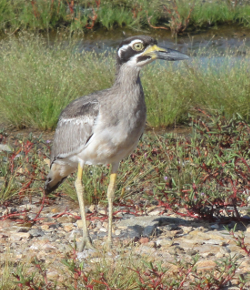|
|
WetlandUpdate 14 December 2016Walking the Landscape—catchment storiesTo effectively manage a catchment it is important to have a collective understanding of how the catchment works. Map journals provide a mechanism for integrating spatial information, photographs and animations with an informative narrative to demonstrate the features of the catchment. The information in the 'catchment stories' was compiled with experts using the 'walking the landscape' process, where experts systematically worked through a catchment in a facilitated workshop, to incorporate diverse knowledge on the landscape. The stories describe the location, extent and values of the Lockyer and mid-Brisbane catchments. They demonstrate the key features which influence water flow, including geology, topography, rainfall and run-off, natural features, human modifications and land uses. Additional catchment stories are under development so watch this space! Delta Downs and Nijinda Durlga (Tarrant) Flyway
Two sites have been added to the Flyway Site Network in the south east Gulf, and these are unique in the respect that they are not part of Ramsar or State land listings and are on Indigenous Managed Land. These nominations were put forward by the Carpentaria Land Council Aboriginal Corporation with the support of Traditional Owners (Kurtijar, Gangalidda and Garawa) and Local Government. Data collected by the Queensland Wader Study Group was essential in supporting the nominations. A site near Karumba (Delta Downs) was added in 2015, and includes 20,000ha of wetlands and is important for species such as the far eastern curlew and the great knot. The Kurtijar Indigenous People run Delta Downs and are working with graziers, ornithologists and the Queensland Government to improve management for migratory shorebirds and raise public awareness of Delta Downs feathered visitors. Benefits from the inclusion of the site in the network include raising the profile of the south-east Gulf at multiple levels, and opportunities for linking the site managers and local community to sites and people in other countries of the flyway. A second property in the south-east Gulf of Carpentaria has been recognised as an important migratory shorebird site on the East Asian—Australasian Flyway. “Tarrant”, part of the Nijinda Durlga Indigenous Protected Area is managed by the Gangalidda and Garawa Indigenous People, and formal recognition was made on 25 October 2016. The site comprises an important section of the larger south-east Gulf of Carpentaria shorebird area, with two major roosts of migratory shorebirds, and includes extensive intertidal mud and sand flats backed by mangroves, bare salt flats and some shelly beaches. Over 10,000 migratory shorebirds of at least 16 species feed and roost in the site, and based on leg flag re-sightings in other parts of the south-east Gulf, some presumably travel on to south-eastern Australia and/or to New Zealand. Updates, improvements and links
WetlandUpdateThe WetlandUpdate is a regular bulletin sent to subscribers to provide them with the latest WetlandInfo resources and tools, as well as case studies, video information and new project fact sheets. View all of the previous WetlandUpdates WetlandInfo feedback and improvementsSend us your useful wetland information and links to add to WetlandInfo. Do you have a wetland question you just can't answer? Email us WetlandInfo feature birdOur WetlandInfo feature bird is Esacus magnirostris, commonly known as the beach stone-curlew or beach thick-knee. They are usually found in pairs on the deserted beaches of northern Australia. They use all types of beaches but are easily disturbed so there are many areas where this bird is not found. They nest in a shallow scrape in the sand and once they establish a site they tend to be faithful to it. WetlandInfo updates this section regularly, so keep your eyes and ears open! For more information on wetland birds, visit Queensland Wader Study Group, Birdlife Australia, Atlas of Living Australia or view species profiles in your area using WetlandSummary. Last updated: 20 December 2016 This page should be cited as: Department of Environment, Science and Innovation, Queensland (2016) WetlandUpdate 14 December 2016, WetlandInfo website, accessed 8 May 2025. Available at: https://wetlandinfo.des.qld.gov.au/wetlands/resources/publications/latest-news/2016-12-21.html |

 — Department of the Environment, Tourism, Science and Innovation
— Department of the Environment, Tourism, Science and Innovation


